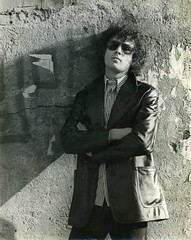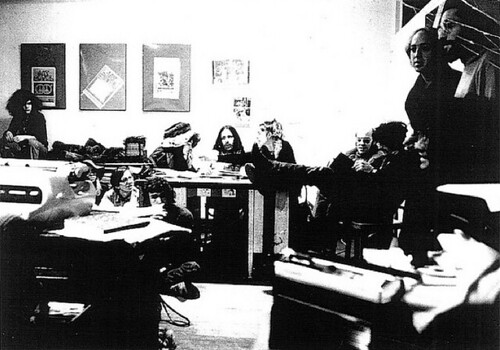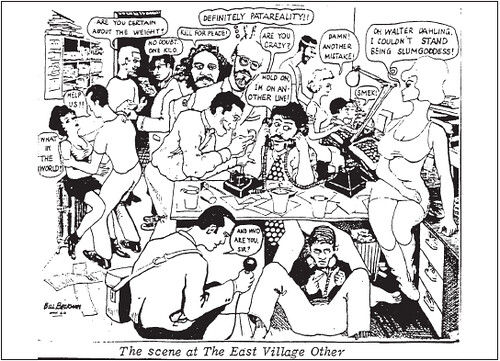 Deanne Stillman Rex Weiner, circa 1971.
Deanne Stillman Rex Weiner, circa 1971.Rex Weiner co-founded The East Village Other’s successor, the pioneering New York Ace (1972–73) and according to his FBI file, was a founding staff member of High Times. He recalls getting his start at EVO.
My first week aboard The East Village Other, its venerable editor-in chief Jaakov Kohn squinted at the name I’d signed to an article, clutched his blue pencil spasmodically, and curled his whiskered lips in disdain. In an Eastern European accent nearly as impenetrable as the cloud of unfiltered Lucky Strike smoke curling from the butt in his nicotine-stained fingers, he declared, “You look more like a Rex to me!”
The newly minted moniker echoed amongst my new colleagues in the vast, shadowy loft. At EVO you had the name you were born with and the name that EVO gave you: Jackie Diamond was Coca Crystal, Alan Shenker was Yossarian, Jackie Friedrich was Roxy Bijou, Jaakov was “The Arab,” Charlie Frick was Zod, and so on. And so with my next byline I was reborn in 1970, a new decade with a new name, and on my way as a writer, of sorts.
I’d walked out of the clanking elevator into the EVO office that fall, a 20-year-old N.Y.U. dropout from upstate and a Lower East Side inhabitant since I was 17. Two of my closest friends from high school were lost, one to Vietnam and the other to heroin, allowing me to nurse a tragic heart tinged with righteous political outrage. With half a dozen porn novels credited to my name — or pseudonym — for a Mafia publisher, and a handful of poems I’d recited at St. Marks in the Bowery, I thought of myself as an established writer. I appointed myself EVO theater critic, filling a staff vacancy, and felt right at home. Read more…
 Kathy Streem Lynda Crawford, 1971
Kathy Streem Lynda Crawford, 1971Breathless — not just from the late-night climb up 11 flights to the EVO office on East 12th Street, or the astonishing art by the likes of Yossarian, Spain, Little Moon, Joe Schenkman, Brad Holland, R. Crumb, Kim Deitch, Trina Robbins, and Fred Mogubgub, or by Dean Latimer‘s gorgeous prose, or the thrill of reading Ray Schultz, or from the stunning reportage of Jackie Friedrich, Pat Morris, and Claudia Dreifus, or the amazing true life adventures of Coca Crystal (subduing a would-be attacker with a tune on her guitar) and Steve Kraus, or the Krassner interview by Kathy Streem, or the wondrous music reviews by Richard Meltzer and Charlie Frick (and Charlie’s magical layouts), or Tuli’s poetry and songs, Vincent Titus’ fables, Honest Bob Singer’s film writings, Rex Weiner’s off-off Broadway reviews (he was homeless and theaters were warm), Tim Leary’s communiqués from Algeria, A. J. Weberman‘s illuminating investigative portraits, or the vocal harmonies of Steve Heller, Latimer, and Schultz; but also from EVO’s coverage of the major events of the time: efforts to stop the Vietnam War, the Pentagon Papers, the Panther 21 trial, American Indian Movement protests, the murder of George Jackson, the Attica uprising, and Bob Dylan’s 30th birthday party, all produced at high intensity under editor Jaakov Kohn‘s benign leadership.
“EVO is not a tit!” I remember editor Allen Katzman telling several of us when salaries were slashed to the single digits, and then disappeared, during the post–salad days of the early 1970s — my tenure.
I waitressed to pay the rent on my $51-per-month apartment on East Sixth Street and to be able to eat a little more than the nightly fare of free chicken wings and chickpeas at Max’s Kansas City that many subsisted on. The EVO piece I wrote that is most remembered came out of that gig at a deli on Christopher Street when John and Yoko happened in one night and I interpreted their relationship through bits of conversation, body language, and by dissecting leftover pieces of blueberry blintz (A. J. gave me kudos for that one); it was reprinted in the Berkeley Barb and a bunch of other papers too. Read more…
 Left to right: Steven Kohn, (on floor:) Heather, R. Crumb, Ray Schultz, (sitting behind:) Hetty Maclise, John Heys, Coca Crystal, Allen Katzman, David Walley, Little Arthur, (standing:) Joel Fabrikant, Jaakov Kohn
Left to right: Steven Kohn, (on floor:) Heather, R. Crumb, Ray Schultz, (sitting behind:) Hetty Maclise, John Heys, Coca Crystal, Allen Katzman, David Walley, Little Arthur, (standing:) Joel Fabrikant, Jaakov KohnThe end of my real involvement with The East Village Other came as something I perceived as a betrayal. I have come to think I really didn’t understand it at the time and perhaps what happened wasn’t directed at me personally. But sometimes I wonder.
I mentioned in my earlier piece that EVO was formed as a stock company, with Walter Bowart, Allen Katzman and I each owning three shares.
“We need to raise more money,” Walter said to me in the spring of 1966. “We’ve run out. I’ve called a meeting and there will be new people coming. We need to get more people buying stock.”
“It won’t dilute my one third, will it?” I asked.
“It doesn’t have to,” he said, “if you buy some more, too.” And this was technically true.
The meeting took place in our office on Avenue A on a Tuesday evening at 8 p.m. John Wilcock was there, a prized defector to The Other from the Village Voice, our designated competitor. I loved that idea. There were four new people in the room, none of whom was familiar to me, except for John.
“Okay, we’re here to buy stock,” Walter said. “Who’d like to go first?” Read more…
Coca Crystal (born Jackie Diamond) was EVO’s self-described “gatekeeper,” receptionist, sometime reporter and sometime model until the bitter end, when, as staff and resources dwindled, she became its defacto publisher (she financed the final two issues out of her own purse). Here, she describes how she got her start.
The first time I set foot in the EVO office, it was in the fall of 1969 and I had come to visit with a college friend, Barbara, who was EVO’s secretary.
The office was located on the third floor of the Fillmore East building on Second Avenue and Sixth Street. The place was a wreck. It was freezing, the garbage cans were overflowing, cigarette butts were everywhere, and the walls were covered in fabulous cartoons by the best in underground comix: R. Crumb, Kim Deitch, Spain Rodriguez, Yossarian, Shelton, Art Spiegelman, just to name a few. It was chaos, but a kind of cool chaos.
The office was in a frenzy to get copy ready for the typesetter, and I was asked if I could type. I said I could and was given the job of typing up the classifieds. I had never seen such weird ads. (“Dominant Iguana seeks submissive zebra,” sex ads, odd employment opportunities, legal advice for pot busts). I had to type while sitting on Allen Katzman’s lap (his idea), wearing my winter coat and gloves. When I had completed the classifieds I was told the other secretary, Marcia, was leaving and I could have her job if I wanted it. The pay was $35 a week. I took the job. Read more…
 Steve Kraus
Steve KrausAs documented in a DNA Info video, Steve Kraus has been publishing the New York Good News since the 1960s. Now 82, he has lived just above Café Mogador on St. Marks Place for the past 37 years. He also volunteers for the Jewish Foundation of the Righteous. The following piece appeared in a 1979 booklet produced by the Alternative Press Syndicate, titled “Alternative Media: How the Muckrakers Saved America,” published by Bell and Howell. It is reprinted here with the author’s permission.
Steve Kraus – How Green Was My Underground
For more on “Blowing Minds: The East Village Other, the Rise of Underground Comix and the Alternative Press, 1965-72,” read about the exhibition here, and read more from EVO’s editors, writers, artists, and associates here.
 Drawing by Bill Beckman, Nov. 1966.
Drawing by Bill Beckman, Nov. 1966.I first knew Walter Bowart around 1963 or ’64 when he was a bartender at Stanley’s Bar, located at 12th Street and Avenue B. Bowart was an artist who did some design work in early 1965 for LeMar, the Committee to Legalize Marijuana, which operated out of my Peace Eye Bookstore located in a former Kosher meat store on East 10th Street between Avenues B and C.
Allen Katzman I had known since 1961 when he helped run open readings at various east-side coffee houses, such as Les Deux Magots on East Seventh, and later the Cafe Le Metro on Second Avenue. Katzman was known at the time mainly as a poet. (During his time at EVO, Katzman spelled his first name Allan.)
During the summer of 1965, Bowart, Katzman and others, including the artist Bill Beckman, Ishmael Reed, Jaakov Kohn, and Sherry Needham, decided to found a newspaper. Poet Ted Berrigan, as I recall, came up with the name, The East Village Other, with “Other” coming, of course, from Rimbaud’s famous line of 1871, “Je est un autre,” I is an Other. Another account has Ishmael Reed coining the name. (The participants in the Dada movement argued for 50 years over who first thought of the name “Dada.”) Read more…
 Fred W. McDarrah/Getty Images From left: Dan Rattiner, Walter Bowart, and brothers Allen and Don Katzman. Jan. 14, 1966.
Fred W. McDarrah/Getty Images From left: Dan Rattiner, Walter Bowart, and brothers Allen and Don Katzman. Jan. 14, 1966.Little is it known that Dan Rattiner, doyen of Dan’s Papers, helped launch the East Village Other alongside its more celebrated founders, the late Walter Bowart and the late Allen Katzman. In 1964, having abandoned graduate school in architecture at Harvard, Mr. Rattiner, in between gigs producing a summer newspaper in Montauk, rented an apartment in a brownstone on West 10th Street in Greenwich Village. A year later, in the fall of 1965, something amazed him on the newsstand at Eighth Street and Sixth Avenue. He picks up the story from there.
It cost 15 cents and was an enormous piece of newsprint all folded up into tabloid size. The four pages, when unfolded looked more like a work of modern art than a newspaper. A new way to print a newspaper was on the market. It involved using scissors and rubber cement to put together a proof of a page, then making a plate from a photograph of it and then printing from that. But I had never seen anyone make use of the new process like this before; most people just used it to mimic the old.
As for the content, it was also revolutionary. The lead headline read: “TO COMMEMORATE THE GLORIOUS NEWSPAPER STRIKE THE HERETOFORE UNDERGROUND ‘OTHER’ EXPANDS ITS PATAREALISM.” In huge black type, the words coiled along the perimeter of the page and ended with a half-tone photograph of a half-closed eye. “Peace Rally Breeds Strange Bedfellows,” was the headline below. “Generation of Draft Dodgers” read another headline below that.
I bought it. And I looked for, and found the name, address and phone number of the publisher and editor, Walter Bowart. Read more…











